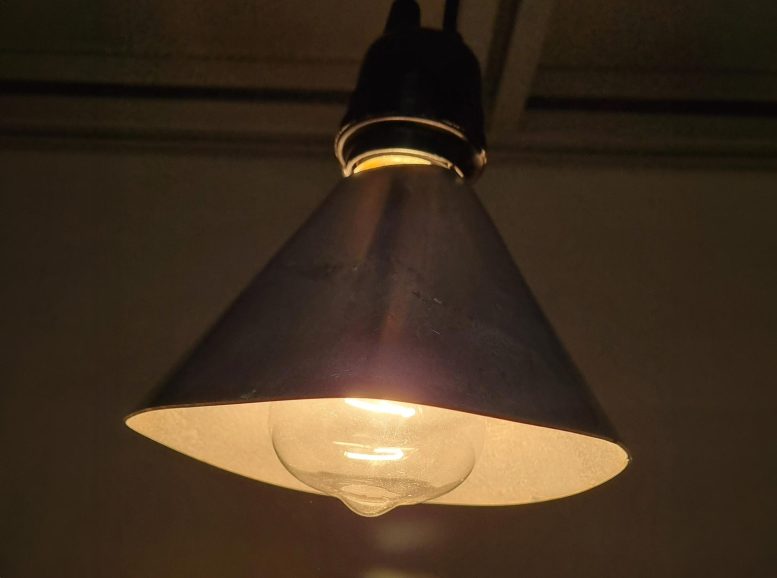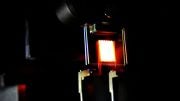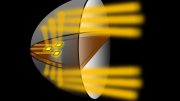
A lampshade coated with a catalyst uses heat from an incandescent bulb to destroy indoor air pollution. Credit: Minhyung Lee
Scientists have designed lampshades that convert indoor air pollutants into benign substances using waste heat from light bulbs, with plans to adapt this technology for LEDs.
Indoor air pollution may have met its match. Scientists report that they have designed catalyst-coated lampshades that transform indoor air pollutants into harmless compounds. The lampshades work with halogen and incandescent light bulbs, and the team is extending the technology so it will also be compatible with LEDs.
Presenting Groundbreaking Research
The researchers presented their results at the fall meeting of the American Chemical Society (ACS). ACS Fall 2023 featured about 12,000 presentations on a wide range of science topics.
Targeting Harmful Compounds
The lampshades target volatile organic compounds (VOCs), which account for most indoor airborne pollutants, according to Hyoung-il Kim, Ph.D., the project’s principal investigator. These compounds include acetaldehyde and formaldehyde and are released by paints, cleaners, air fresheners, plastics, furniture, cooking, and other sources.
“Although the concentration of VOCs in a home or office is low, people spend more than 90% of their time indoors, so the exposure adds up over time,” Kim says.
“Conventional methods to remove VOCs from indoor air rely on activated carbon or other types of filters, which have to be replaced periodically,” says Minhyung Lee, a graduate student in Kim’s lab at Yonsei University. Lee will present the team’s work at the ACS meeting. Other devices have been developed that break down VOCs with the help of thermocatalysts activated by high temperatures or with photocatalysts, which respond to light. But Kim notes that most of these units need a separate heater or an ultraviolet (UV) light source, which can produce unwanted byproducts. His team wanted to take a simpler approach that would only require a visible light source that also produces heat — such as a halogen or incandescent bulb — and a lampshade coated with a thermocatalyst.
Harnessing Waste Heat
Halogen bulbs convert a mere 10% of the power they use into light, with the other 90% being transformed into heat, according to Lee. Incandescent bulbs are even worse, emitting 5% light and 95% heat. “That heat is typically wasted,” Kim says, “but we decided to use it to activate a thermocatalyst to decompose VOCs.”
In a paper published last fall, the team reported that they had synthesized thermocatalysts made of titanium dioxide and a small amount of platinum. The researchers coated the inside of an aluminum lampshade with the catalyst and placed the shade over a 100-watt halogen bulb in a test chamber containing air and acetaldehyde gas. Turning the lamp on heated the shade to temperatures up to about 250 degrees Fahrenheit — warm enough to activate the catalysts and decompose acetaldehyde. During this oxidation process, the VOC was initially converted into acetic acid, then into formic acid, and finally into carbon dioxide and water. Both of the acids are mild, and the amount of carbon dioxide released is harmless, Kim notes. The researchers also found that formaldehyde can be decomposed under the same conditions and that the technique works with incandescent bulbs.
“This was the first demonstration to utilize waste heat from lamp sources,” Kim says. Most previous research projects, and even a couple of lamps on the market, have instead relied on light-activated photocatalysts to destroy indoor air pollution.
Future Directions and Innovations
Recently, Kim’s team has been exploring less expensive substitutes for platinum. The team has already shown that these new iron- or copper-based catalysts can break down VOCs. In addition, copper is a disinfectant, so Kim anticipates that the copper catalyst could kill airborne microorganisms.
Now, the scientists are looking for ways to extend the pollution-destroying lampshade concept to LEDs, a fast-growing segment of the lighting market. Unlike halogen and incandescent bulbs, however, LEDs release too little heat to activate thermocatalysts. Therefore, Kim’s team is developing photocatalysts that are stimulated by the near-UV light emitted by LEDs, as well as other catalysts that transform part of the LEDs’ visible light output into heat.
“Our ultimate goal is to develop a hybrid catalyst that can utilize the full spectrum produced by light sources, including UV and visible light, as well as waste heat,” Kim says.
Meeting: ACS Fall 2023
The researchers acknowledge support and funding from the National Research Foundation of Korea; Ministry of Land, Infrastructure and Transport; Ministry of Environment; and Ministry of Trade, Industry and Energy.
Title
Thermocatalytic oxidation of VOC through harnessing indoor waste heat
Abstract
With the onset of modernization, the time spent indoors has increased due to the severity of air pollution (SARS-CoV-2, fine dust, airborne microorganisms, and volatile organic compounds). Hazardous air pollutants mainly occur in various industrial and interior sources. However, due to poor air circulation, more pollutants are exhibited indoors than outdoors. Conventional methods of removing VOC using activated carbon or filters have been used, but these methods require periodic replacement. Technologies such as photocatalysts using ultraviolet light and thermal catalysts using high temperatures (200 ~ 400 °C) have been studied a lot, but these methods have a problem in that they require additional equipment.
In here, we introduce the low-temperature thermocatalysis system that effectively acts on the waste heat from indoor lamps (e.g., halogen-, incandescent-, sodium- and metal halide lamps). Pt-TiO2, which can exhibit high catalytic activity by loading a trace amount of platinum nanoparticles on the TiO2 catalyst surface, was used as the optimal thermocatalyst. The Pt-TiO2 catalyst can adsorb/remove a high concentration of VOC even at room temperature. In addition, VOC is completely oxidized and converted into harmless CO2 under the condition of 120 °C, which is the lowest heating temperature of indoor bulbs. Furthermore, by coating the thermocatalyst on the indoor lampshade, we first implemented a thermocatalyst system using waste heat that can remove VOCs in an eco-friendly way without an additional heat supply device. The proposed thermocatalytic system offers a sustainable and feasible indoor VOC removal method.









Really interesting. I would happily resume operation of my dinosaur-era lightbulb depending on the efficiency of the decomposition of VOCs. If it only works slowly inside a test chamber, maybe not, but also depending on the cost of the small quantity of platinum needed. Titanium Dioxide is also cheap, found in white paint and soup and ice cream these days. Computer heatsinks and refridgerator compressors also can reach 120c. I was going to comment laughing about adding a resistor to LEDs to generate heat, but using ultraviolet to power the conversion would be even cooler, uh literally.
I like that this article included the abstract. They are phrased differently from press releases, and usually add technical information.